Summary
Flea combs are helpful for diagnosing fleas on pets, as they make finding adult fleas and their feces easier. Flea combs are also useful for treating young puppies and kittens that can’t tolerate insecticides. However, in most cases, combing only removes a small portion of the fleas (10-60%).
Safari’s dog flea comb is the best choice, based on price and customer reviews. It features a double row of teeth to help remove and trap fleas. However, a comb with a single row of longer teeth may be better for cats, and dogs with long hair. These features will prevent tangles. Sentry’s flea comb is a good choice.
Comparison
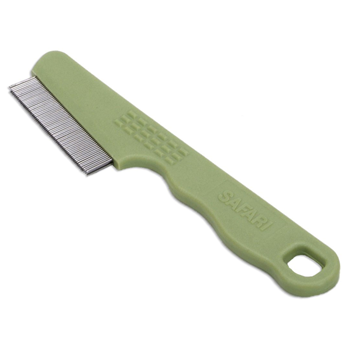 |
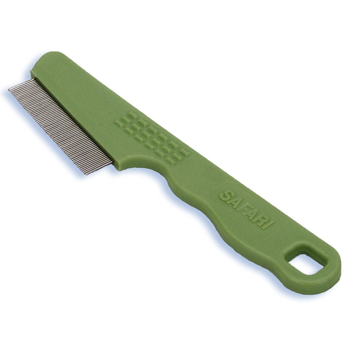 |
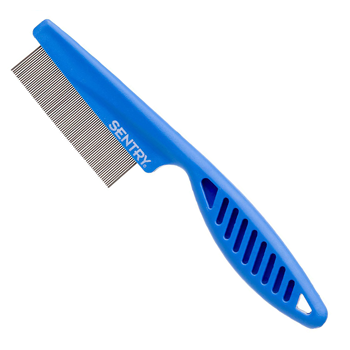 |
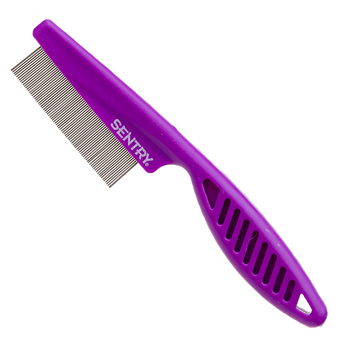 |
|
| Product Name | Safari Dog Flea Comb | Safari Cat Flea Comb | Sentry Dog Flea Comb | Sentry Cat Flea Comb |
| Price | $4 | $5 | $7 | $6 |
| Use On | Dogs | Cats | Dogs | Cats |
| Handle Material | Plastic | Plastic | Plastic | Plastic |
| Teeth Material | Metal | Metal | Metal | Metal |
| Teeth Ends | Rounded | Rounded | Rounded | Rounded |
| Teeth Rows | Double | Single | Single | Single |
| Teeth Length | 1/2 inch | 1/2 inch | 3/4 inch | 3/4 inch |
| Teeth/Inch | 30 | 30 | 30 | 30 |
| Removes | Eggs Adults Flea Dirt |
Eggs Adults Flea Dirt |
Eggs Adults Flea Dirt |
Eggs Adults Flea Dirt |
| FleaScore | ||||
| Reviews |
- Prices are based on Amazon.com at time of publishing.
- FleaScores are based off of product details (price, size, active ingredients, etc), as well as reviews aggregated from 3rd party sources.
Details
Flea Material found on Animals
Adult Fleas
Cat fleas are permanent parasites. Upon acquiring a host, they’ll stay there and rarely leave on their own. They’ll feed, mate, and lay eggs directly on the animal. These activities continue until the fleas die or are dislodged.
Fleas prefer living on the neck, lower back, and belly area of animals. The fewest fleas will be found on the legs and tail. On cats, more fleas tend to live around the neck region. On dogs, fleas are more prone to living near the ventral (underside) areas and hindquarters.
Flea Eggs
Adult fleas mate and lay eggs on their host. The eggs gets deposited into the haircoat. The eggs are wet and sticky when laid, but they dry rapidly. Once dry, the eggs become non-adherent and easily fall from the animal. Most eggs drop into the environment within a few hours of being laid. How quickly they fall depends upon the host’s hair-coat and grooming behavior.
Flea Feces
Fleas consume much more blood than they can use. As a result, they produce large amounts of feces. The feces, or “flea dirt”, consists of partially digested host blood. Fleas defecate directly on the host animal. The feces dries in irregular shapes and can get embedded into pet fur. However, the dry blood dislodges and falls into the environment when animals scratch and groom themselves.
How Flea Combs Work
Flea combs have numerous fine teeth which are closely spaced together. There are usually around 30 teeth per inch. When pets are combed, their hairs pass through the gaps of the teeth, but fleas, flea dirt, and flea eggs are too large and get trapped. The fleas and related debris can then be removed from the host.
Flea Comb Uses
Diagnosing Infestations
Finding adult fleas or their feces on pets is the best way to diagnose an infestation. Close examination of pets can reveal fleas and flea dirt. However, combing animals with a flea comb is the recommended way to identify fleas. Fleas can be difficult to notice on pets. In one experiment, fleas were only seen on 33% of infested animals. When a flea comb was used, pet-owners could more easily find the fleas. The comb increased flea detection to 66% of infested animals.
Finding flea feces is more common than finding the actual insects. As a result, discovering the feces on pets is the easiest way to diagnose an infestation. Flea combs also remove flea eggs from animals. However, the eggs are very small and white, making them difficult to see without magnification. Plus, many of the non-adherent eggs will fall off before or during combing.
Controlling Fleas
Flea combs can help control fleas on pets, but only a small portion of the insects will be removed. Generally, combing removes 10-60% of fleas. An hour after pets acquire fleas, it can be difficult to find more than 25-30% of the population. The efficacy of flea combs was tested on beagles. 25, 50, and 100 fleas were placed on the dogs. Combing for 10 minutes removed 81.4%, 87.5%, and 76% of the fleas, respectively. Even with extensive combing, only 94% of fleas could be recovered in one study.
Flea combs aren’t 100% effective because fleas are well-adapted for moving on hosts. For example, they have a flexible, laterally-compressed body, which allows them to effortlessly run through host hair without resistance. They can quickly move away from the comb’s path. Using a small number of slow, long, continuous strokes will remove dead fleas from pet hair, but most live fleas will escape.
Daily combing can remove large numbers of fleas, but it requires time and effort. Plus, it’s limited by the animal’s temperament and haircoat. Operator experience also limits the efficacy of combing. Combing is most effective on short-haired animals. It’s difficult to pass the fine-toothed combs through long, dense hair. Combing is more useful on cats than dogs, because dogs are more tolerant to getting baths.
Flea combing is among the safest methods of flea control on pets. It may be the treatment of choice for infested puppies or kittens, because they can’t tolerate insecticides if they’re too young. However, in most cases, even with combing, insecticides treatments are necessary on the animal and in the environment for complete control.
Counting Fleas
Flea combs are useful for counting fleas and assessing the severity of infestations. Of the different counting methods, comb-counting provides the best results. All fleas won’t be found, but comb counts allow for reasonable estimations of on-host populations. Comb counts are used by researchers to evaluate the efficacy, speed of kill, and dose selection of pet treatments.
Safari Flea Combs
Safari Comb for Dogs
Safari’s dog flea comb has two rows of teeth. It’s good for short-haired breeds.
This safari flea comb for dogs has around 30 teeth per inch. The teeth are half an inch long, a length well-suited for short-haired dog breeds. This comb stands out from others with its double row of teeth. The double row helps remove more fleas, and also traps them between the rows (which some users don’t like). This comb is around $4, and is among the cheapest flea combs. It has great reviews and is a bestseller on Amazon.
Safari Comb for Cats
Safari’s comb for cats has a single row of teeth, which is better for passing through cat hair.
Safari’s cat flea comb also has 1/2″ long teeth and 30 teeth per inch. However, the cat comb has a single row of teeth. Cat hair is more fine and prone to tangles than dog hair. The single row of teeth passes through cat fur easier than the double row. However, customers have used the cat comb on dogs, and the dog comb on cats, and have been satisfied.
Sentry Flea Combs
Sentry Comb for Dogs
The Sentry comb for dogs has a single row of 3/4 inch long teeth. It’s a good choice for long-haired dogs.
Sentry’s flea comb for dogs has 30 teeth per inch. What separates it from Safari’s dog comb is that there’s only a single row of teeth, and the teeth are longer (3/4 inch). The longer teeth are more suitable for long-haired dog breeds. The single row of teeth also prevents the comb from getting lodged in the longer, denser hair.
Sentry Comb for Cats
Sentry’s comb for cats is nearly identical to the dog comb, aside from the handle color and price.
Sentry’s flea comb for cats appears identical to the company’s dog comb. They both have a single row of 3/4″ teeth, with 30 teeth per inch. The only discernible difference is the handle color and price. Sentry’s cat comb is also similar to Safari’s cat comb, but with longer teeth. As a result, Sentry’s comb may be a better choice for cats with long hair.
How to Use Flea Combs
Strokes
When using a flea comb, stroke the entire length of the animal’s hair-coat. Start with the head and work backwards. Go in the same direction with all strokes, following the pattern of the hair coat. Use overlapping strokes to ensure no area of fur is missed.
Duration
Most sources suggest combing for at least 10 minutes, adding 5 minutes every time a flea is found. The process ends once fleas aren’t found for 5 minutes. A similar method involves counting strokes instead of minutes. Start with a minimum of 200 strokes, and add 50 strokes every time a flea is found. To make the exercise worthwhile, one source recommends combing daily for at least 30-60 minutes. Higher levels of infestation will result in longer combing times. Likewise, longer and denser hair-coats may increase the duration.
Disposing of Fleas
Drop any removed fleas and eggs into a container of soapy water. Swirl the water to submerge and drown the fleas. Use a liquid detergent, such as Dawn. Detergents contain surfactants that reduce the surface tension of water. A couple drops will cause fleas to sink in the water. Without the surfactant, fleas will stay on the water’s surface and possibly escape.
Identifying Feces & Eggs
Flea feces appears as tiny, irregular-shaped, dark red or black specks. It resembles black pepper or black dandruff. To positively identify flea dirt, place the suspected particles on white paper or white fabric. Then moisten the specks with water. If it’s flea dirt, the black specks will reconstitute into blood and smear into a rusty red color. Similarly, placing flea dirt into a water droplet will turn the water red.
Flea eggs are tiny, oval-shaped, and white. They can be seen with the naked eye, but not easily. White particulates removed from pet fur while combing may be flea eggs or dander. To get a better look, a hand-held magnifying lens can help. Also, placing the eggs on a dark background makes them more visible.



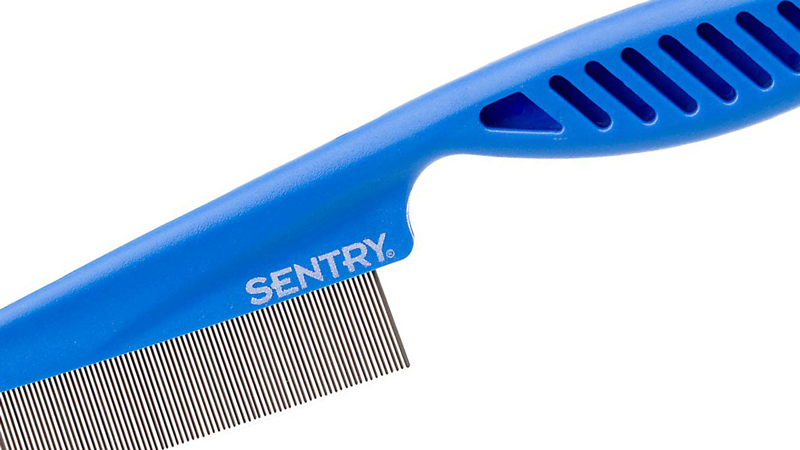
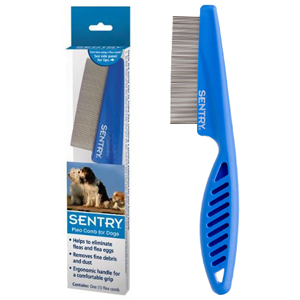



You must log in to post a comment. Log in now.